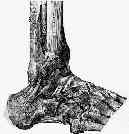- See: anterolateral approach to the ankle

- Anatomy:
- peroneus brevis is anterior to peroneus longus at level of ankle joint and is closer to lateral malleolus; (brevis is muscular almost down to the ankle);
- flexor hallucis longus is most lateral of deep flexor muscles of calf & is still muscular at this level;
- inter-nervous plane:
- lies between peroneus tertius (deep peroneal) & peroneus brevis;
- location of cutaneous nerves: (from Huene and Bunnell 1995)
- branches of the superficial peroneal nerve or the sural nerve may be injured during the dissection;
- these nerves are most at risk at the junction of the distal and middle thirds of the lateral border of the fibula;
- in 22% of legs, braches of either nerve will cross the frx site;
- in 54% of legs, branches of superficial peroneal will lie within 5 mm of the anterolateral border of the fibula;
- safest interval is 12 mm posterior to the anterolateral border of the fibula at 10 cm from the fibular tip, and 10 mm posterior to the anterolateral border at 5 cm proximal to the tip;
- Surgical Approach for Weber B Frx:
- general principal is to avoid making an incision directly over the site where the plate will lie;
- fixation w/ two lag screws:
- lag screws will be inserted from anterior to posterior, and therefore, make the incision slightly anterior to the midline;
- this will facilitate insertion of the lag screws, but placing the incision too far anterior will make the reduction more difficult;
- because only lag screws are inserted a smaller incision can be used;
- achieves strong fixation (even in osteoporotic bone);
- generally hardware does not cause symptoms nor does it cause wound necrosis;
- does not interfere w/ syndesmotic screw insertion;
- posterior antiglide plate:
- this incision allows acess to the posterior fibula as well as the posterior malleolus (for trimalleolar frx);
- because the plate often lies slightly posterolateral (rather than directly posterior), the incision can be made along the most posterior border of the fibula (hence the incision is well away from the plate);
- if the incision is made too posterior, reduction of the fracture will be more difficult, but there will be easier access to the posterior malleolus (and vice versa if the incision is made to lateral);
- the incision is carried down to the peroneals but does not enter the tendon sheath;
- the dissection usually proceeds over the lateral edge of the peroneals, but may also be brought behind the peroneals for proximal access to the frx, or for access to the posterior malleolus;
- cautions:
- main risk is to the sural nerve
- generally hardware does not cause symptoms nor does it cause wound necrosis;
- lateral plate and lag screw:
- because the plate will be applied laterally (or posterolaterally), consider placing the incision slightly anterior to the midline;
- this will keep the incision away from the plate and will facilitate insertion of lag screws;
- distally, the incision is carried down directly to the fibula;
- proximally, the incision is carried down to the superficial fascia over the lateral compartment;
- in proximal portion of the fibula, the superficial peroneal nerve lies beneath fascia and is at risk for injury;
- the superficial fascia is incised to reveal the peroneals, which are then retract posteriorly w/ small Homan's or metacarpal retractors;
- cautions:
- this incision does not allow direct access to posterior malleolar frx;
- prominent lateral screws may cause symptoms or wound necrosis;
- its important to avoid injuring the peroneal tendons;
- periosteum over lateral edge of fibula is elevated w/ 15 blade scalpel (or a small periosteal elevator) for
a length sufficient to allow plate application;
- #15 blade is used to remove periosteum from edges of fracture site.
- fracture hematoma is curetted free from the bone ends.
Operative Anatomy of Nerves Encountered in the Lateral Approach to the Distal Part of the Fibula.
Investigation of incidence of superficial peroneal nerve injury following ankle fracture.



